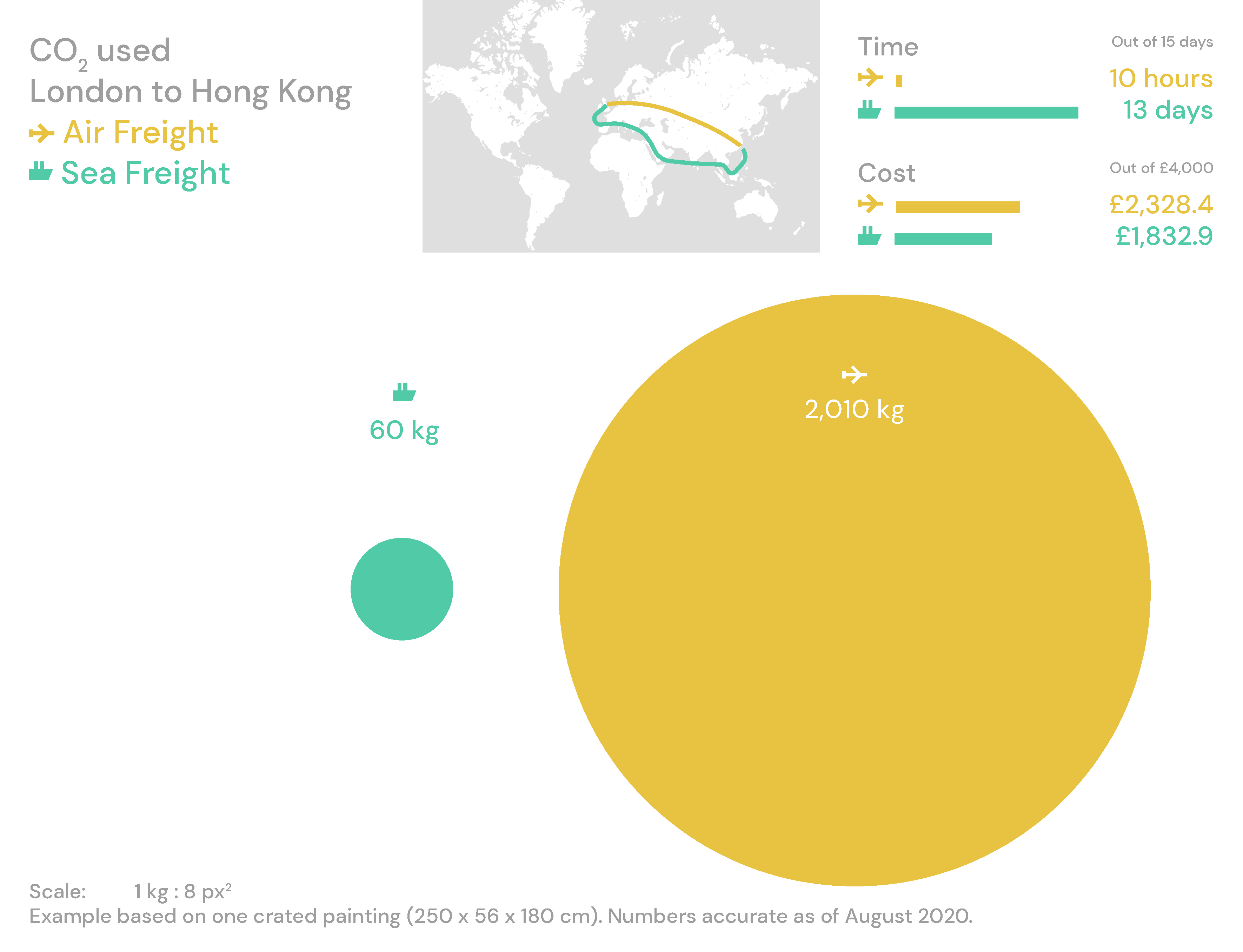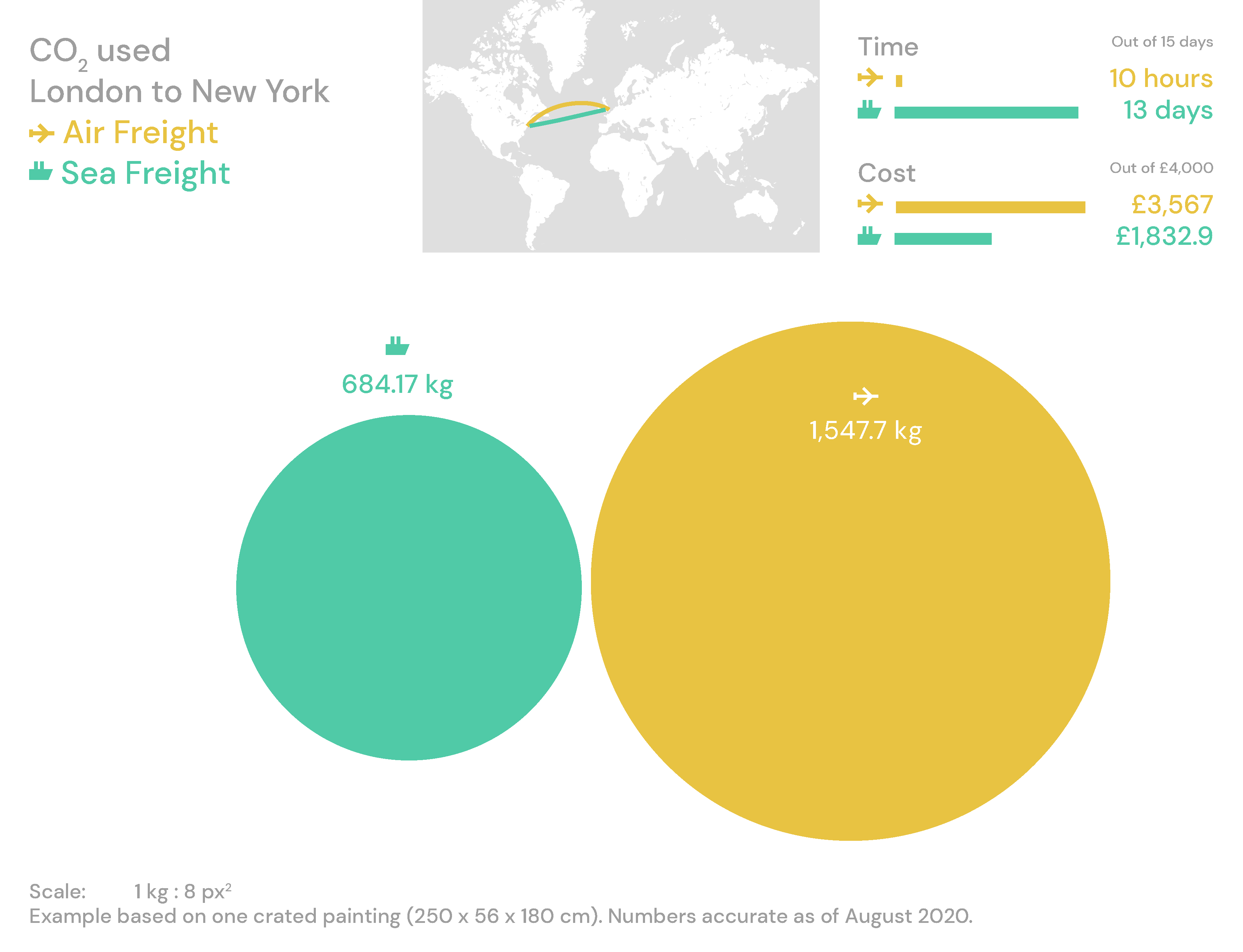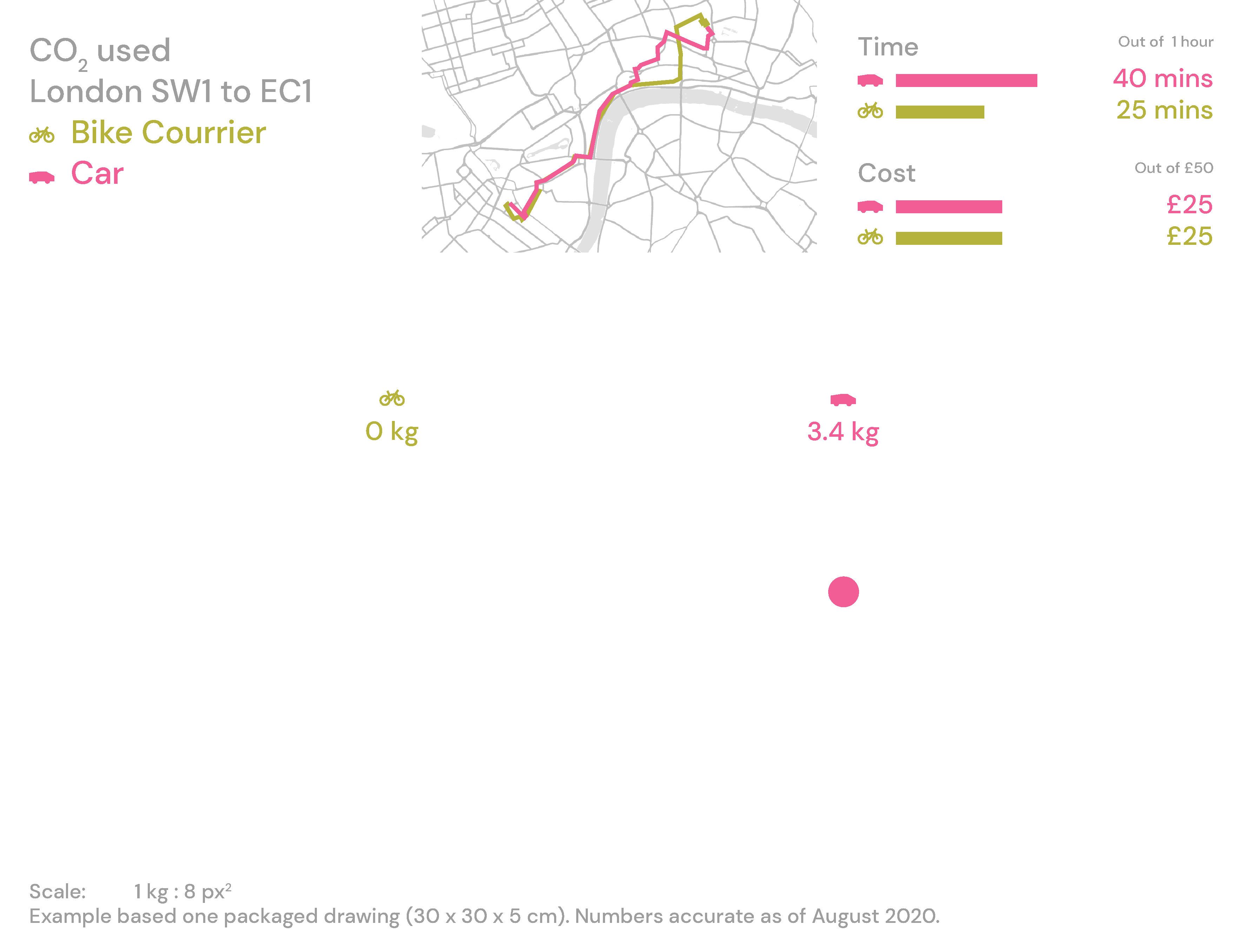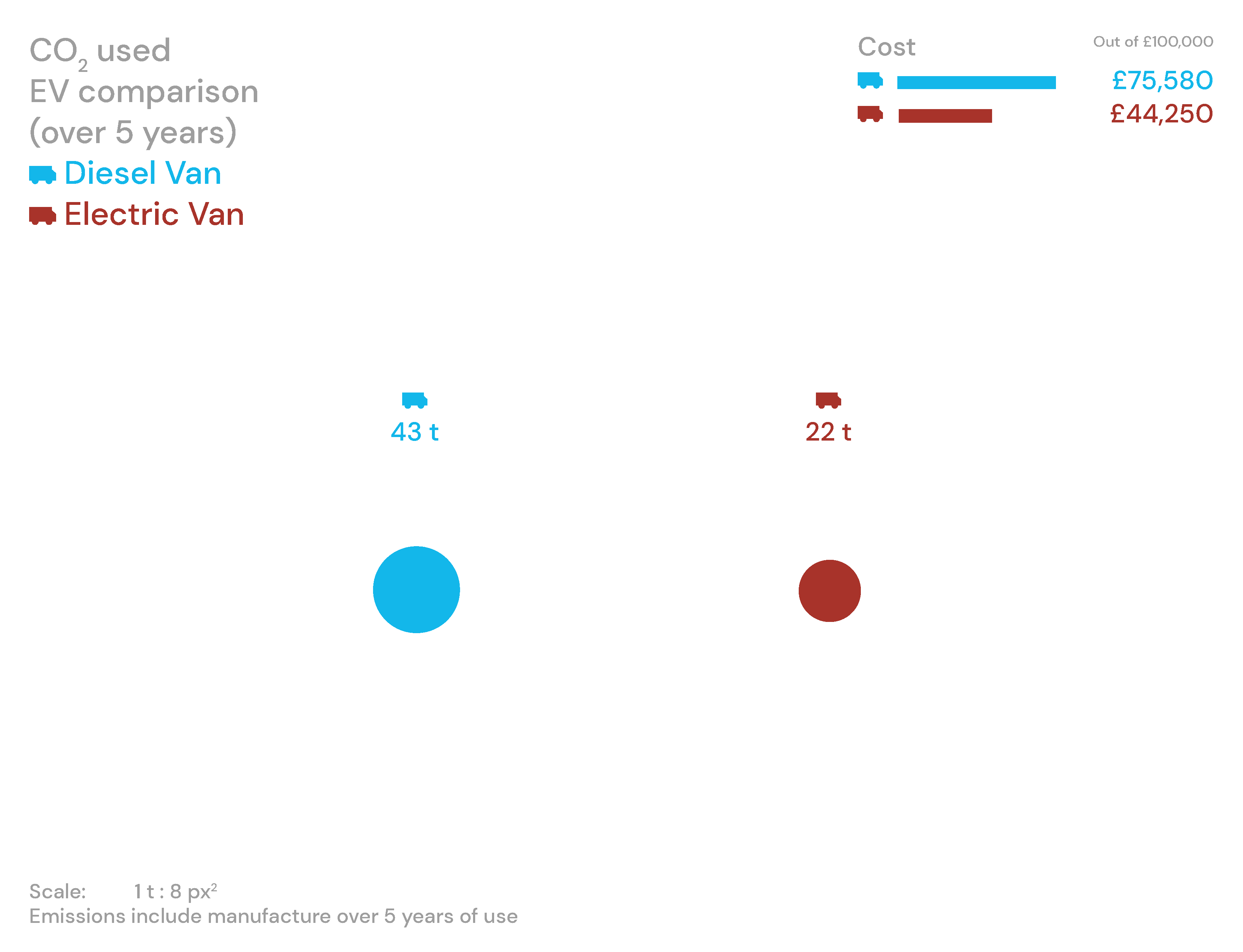-
Overview
- 'Shipping' here refers to the transportation of artworks and materials via air, sea, road or rail.
- Moving a piece of art by ocean rather than air can reduce its journey's impact on the climate by around 95%.
- In order to reach the 2030 50% CO2e reduction targets, there needs to be a sector wide reduction in overall volumes of shipping. This requires careful consideration of consolidation, programming, as well as better application of packing materials solutions.
- Alternative methods of transportation might take longer but other advantages may be gained, such as cost savings. Re-evaluating expected delivery times can lead to a significant reduction in carbon emissions. The main hurdles to overcome in this area are the implications of longer lead times on schedules. However, by starting the conversation with clients, artists and shippers - and communicating the impacts vs benefits debate - the long term advantages should soon become apparent.
- Simple and cost-effective changes to local transportation methods, such as zero and low emissions vehicles will reduce emissions and local pollution.
- To support the transition to environmentally responsible freight operations, GCC launched its Sustainable Shipping Campaign in May 2022. For more information see: Sector-wide Targets and Campaign Actions for Galleries, Museums, Art Fairs, Collectors and Artists.
-
Sustainable Shipping Campaign
The transportation of goods via air freight is a major contributor of carbon emissions in the art sector. The Sustainable Shipping Campaign aims to combat this by accelerating the international art sector's transition to environmentally responsible freight options. In collaboration with leading arts organisations and key industry suppliers, this campaign hopes to challenge and adapt current dependencies on air freight and single-use plastic packaging.Sector-wide campaign targets
- A majority of all international art freight to be transported via non-air methods¹ - with an overall reduction in volume² - by 2028³.
- The majority of packing materials in circulation to be reusable or curbsiderecyclable⁴ by 2026, as well as an immediate phase-out of single-use plastic products with zero-waste⁵ by 2030.
- Local deliveries⁶ to be low or zero emissions by 2025⁷.
- By 2024 - all freight companies to provide standardised emissions data:
a) as estimates on all quotations so that clients can make informed decisions on shipping options based on environmental impacts as well as cost and time⁸.
b) on all invoices allowing clients to efficiently collect the required data for emissions reporting⁹.
Reference the Sustainable Shipping Campaign for more information about the campaign, including free resources and effective actions for galleries, institutions, museums and auction houses, as well as shippers, artists, art fairs, and collectors.
Detailed target footnotes can be found here.
-

Air Freight
Air freight presents a vastly larger emissions potential than other forms of shipping. Thomas Dane Gallery's carbon audit revealed that shipping artworks by plane accounted for 45% of their total emissions in 2018/19 - 97.2 tCO2e in total.
A major reason why flights have such a big impact is the extra warming that comes from burning jet fuel at high altitude, known as radiative forcing (RF).
For each tonne of cargo shipped one kilometre, this inforgraphic shows the amounts of CO2 in grams which is emitted per method of transport.

-

Sea FreightTransporting an artwork by air has, on average, sixty times more climate impact than moving it the same distance by sea. For a typical arts organisation, air freight may be the most environmentally impactful activity they will undertake.¹ Comparisons of road, sea, and air freight emissions on common freight routes can be found here.

In 2019 - following a commissioned report to compare air and sea freight - artist Gary Hume chose to transport all works for his exhibition at Matthew Marks Gallery via sea freight from London to New York. This resulted in a notably lighter carbon footprint as well as significantly reduced costs.

Advantages of sea freight
- Significantly less GHG emissions, when compared to air. Utilising sea freight is an efficient way of drastically reducing emissions.
- Prior to the Covid-19 pandemic, ocean freight was a very cost effective form of international shipping. Due to recent disruptions* prices have been unpredictable. However, as supply chains begin to stabilise, costs are beginning to come down.
- Easier to ship larger and heavier artworks.
- Lloyds Market Association Joint Specie Committee to develop guidelines to mitigate and insure risk of damage during sea shipment.
Perceived disadvantages for sea freight
- Longer lead times - this can be managed by forward planning.
- Risk of damage to artworks - specify type and position of container in ship.
- Not possible for all destinations - can be managed by combining with road transport.
- Some materials are deemed unsuitable to ship by sea - this is likely to change if sea freight becomes more standard.
- Unexpected custom delays should be built into the timeline. Hopefully this will improve as sea freight grows in demand.
¹ For every tonne of artwork, air freight produces around 10 times more CO2e than freight the same distance by road, and around 60 times more CO2e than the same distance by sea (Source: UK government carbon reporting factors). Currently, air freight makes up 75% - 95% of the total amount shipped (in tonne-km) by a typical commercial art gallery (the remainder is a mix of road and sea freight). As a result, air freight alone makes up around half of all the emissions from GCC members’ operations (based on member footprints calculated to date).*GCC acknowledges that due to the disruptions caused by Brexit, the Covid-19 pandemic, the Suez Canal blockage, and conflict in Eastern Europe there are currently major disruptions to global freight services, resulting in delays and additional costs. These are (hopefully) temporary complications, which will be resolved in time allowing a return to the cost saving advantages of non-air freight methods.
-

Road FreightWhile road freight is still polluting, if the distances involved are relatively small then it is preferable and a cheaper alternative to air freight without significantly impacting the lead time. Consolidated trucks are widely available and should be used wherever possible.
Trucks are still mainly fossil-fuel powered, however electric and hybrid alternatives are developing with an increasing pace year-on-year. This is a quickly evolving area within the transport sector, and advice will change as tech and protocols change.
There are now several major vehicle manufacturers who are developing or have already released electric HGVs to the market. Whilst they are more expensive than fossil fuel vehicles and do require more energy to manufacture, cost savings on diesel will make them more economic in the long run. The potential to replace polluting power sources with renewable energy in national electricity grids will also make electric HGVs an increasingly low-carbon option.
There are also new opportunities for implementing new data technology and smart logistics to reduce the amount of empty road freight loads. More information on the environmental considerations of international shipping can be found here.
Advantages of road freight
-
Significantly less carbon emissions than air, per unit shipped
-
Often much cheaper than air
-
Easier to consolidate large shipments
-
Crating is not essential
-
Electric HGV options are already available in some locations. Major companies such as John Lewis and Tesco in the UK, and FedEx, DHL and others in the US have already started to electrify their delivery fleets.
Perceived disadvantages for road freight
-
Longer lead times - this can be managed with forward planning
-
Not possible to all destinations
-
Potentially more customs depending on route
-
-
Environmental Considerations of Sea and Road Freight
Sea and even road freight can offer a significantly cleaner and cheaper alternative to air freight, even though these options come with their own environmental impacts. For more details reference the Environmental Considerations of International Shipping. Despite the negative impacts outlined here, sea and road freight are still the best options to significantly reduce our carbon emissions by 2030.
Environmental negatives of sea freight and responses:-
Untreated ballast water released into parts of the ocean different to where it is taken on, can introduce new invasive marine species that can damage the natural ecosystem. Ballast water treatment is an increasingly viable option, both on ship and at certain ports.
-
Ballast water should be treated to prevent the spread of any invasive species.
-
Anti-fouling coatings (biocides) are applied to the hulls of ships to prevent growths and maintain speed efficiency. When the hull is cleaned the paints and chemicals used in the coatings are transferred to the ocean. These are toxic to marine life.
-
There are less toxic hull treatments available and they should be implemented as a standard.
-
Sewage and garbage from humans on ships often gets transferred to the ocean rather than being properly disposed, which is damaging to marine life and ecosystems.
-
Stricter rules on ocean dumping should be developed and implemented. Arts organisations can contribute to this by requesting higher standards.
-
International shipping uses low-grade diesel fuel and produces high levels of air pollution.
-
Though development is slow, many shipping companies are experimenting with more efficient ship designs and are installing electric charging at seaports to limit use of their diesel engines while docked.
Environmental negatives of road freight and responses:
-
Air pollution from fossil-fuelled vehicles has a significant impact on the climate, as well as people’s health.
-
Several major vehicle manufacturers are developing or have already released electric HGVS. If national electricity grids continue to replace polluting power sources with renewable energy, electric HGVs will become an increasingly low-carbon option.
-
Trucks drive billions of miles each year empty or only partially full. Capturing even half of the unused capacity could reduce carbon emissions by as much as 100 million tonnes per year.
-
New developments in technology and smart logistics can be implemented to capture wasted capacity and reduce empty freight loads.
-
-

Local TransportTarget 3 of the Sustainable Shipping Campaign states that local deliveries should be low or zero emissions by 2025. Some options for reaching this target include bike courier services and electric vans.
Most couriers now offer electric bike options for short distance transport. These have the capability to carry several framed artworks or small paintings and sculptures around a city. Depending on insurance limits for non fine art transport, electric bikes are an easy way to move artworks around safely and reduce GHG emissions locally. Check with your couriers to see what options are available.

Electric last mile delivery vans can drastically reduce CO2e emissions during transport. Despite the high costs of electric vehicles and the emissions associated with their manufacturing, the low emissions from running the vehicles more than make up for this in the long run. A comparison of the costs and emissions of diesel versus electric vans can be found here.

-
International Couriers
Sending documents and thin packages via courier generally has a small associated carbon footprint as they are consolidated and the process is streamlined. However, this does not mean that best practice should not be followed. Consider improving the type of packaging materials used and where reductions can be made. Check with couriers to make sure you are on a green tariff and not set to a priority service by default.
-
Effective Actions
-
Review the material from GCC’s Sustainable Shipping Campaign and follow the the Actions and Targets.
-
Prioritise consolidated road and sea freight, over air, for local and international shipments.
-
Superior service should be predicated on environmental considerations rather than speed of delivery.
-
Request hybrid or electric transport wherever possible.
-
Plan shipping schedules as far in advance as possible and involve artists and clients in the process so they are aware of the deadlines and shipping times.
-
Only work with suppliers and shipping companies who support sustainability.
-
Start a conversation with your insurance company and consult GCC’s best practice for insuring sea shipments.
-
Collaborate with other galleries to coordinate and consolidate shipping wherever possible.
-
Use Zero Emissions vehicles, or bikes, for local courier and short transport journeys.
-
Check the couriers you use have a green tariff and make that your default service.
-
Keep a clear record of all shipments sent and received and ask shipping companies to keep their own thorough records, in line with the carbon calculator requirements; this will save time in future audits.
-
Internationally transporting artworks and materials - specifically via air freight - is one of the biggest contributors to greenhouse gas emissions in the art sector. Through better forward planning and use of alternative methods there is significant potential to reduce the associated environmental impacts.
